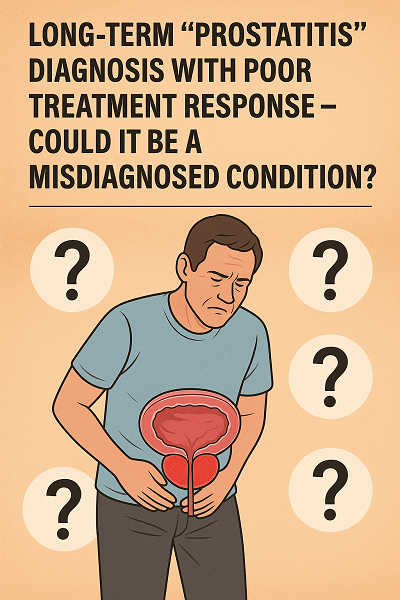Long-term "Prostatitis" Diagnosis with Poor Treatment Response - Could It Be a Misdiagnosed Condition?
Prostatitis is pretty familiar territory for a lot of guys out there – it's probably one of the most common diagnoses you'll hear in a urology clinic. But here's the thing: many men have been through this frustrating cycle where their doctor says it's prostatitis, prescribes antibiotics and anti-inflammatory meds, maybe even tries various other treatments, but the symptoms just won't budge. Sometimes they even keep coming back. When you're stuck in this situation, it's only natural to start wondering: "Is this diagnosis actually right? Could there be something else going on?"

Why Is Prostatitis So Easy to "Misdiagnose"?
Let's be honest – diagnosing prostatitis can be a real headache for doctors. There are several reasons for this:
First off, prostatitis symptoms are frustratingly "generic." We're talking about frequent urination, urgency, lower abdominal discomfort, perineal pain, lower back aches. These are symptoms that pretty much anyone can relate to, but here's the catch – plenty of other conditions can cause the exact same problems. It's like how both a cold and the flu can give you a fever – just looking at symptoms doesn't always tell the whole story.
Then there's the fact that chronic prostatitis, especially the chronic non-bacterial type, doesn't have any slam-dunk diagnostic tests. Doctors mainly have to rely on what patients tell them about their symptoms, plus some routine tests. But this approach inevitably has a subjective element that can lead to mistakes.
And here's something we can't ignore – at some smaller hospitals or clinics, when patients show up with these urinary symptoms, doctors might reflexively think "prostatitis" first. After all, it's genuinely common, and the diagnosis and treatment are relatively standardized." But this knee-jerk reaction can sometimes mean other possibilities get overlooked.
The Real Culprits Behind Those "Prostatitis" Symptoms
1. Bladder Neck Sclerosis
This condition might sound unfamiliar, but it's actually a master of disguise. Patients feel almost exactly like they have prostatitis: trouble urinating, frequent trips to the bathroom, urgency, sometimes even pain. But the real problem is at the bladder neck, where the tissue has hardened up – kind of like a pipe getting clogged.
Think about it – if the problem is at the "pipe opening," treating the prostate isn't going to do much good. This condition needs a cystoscopy to diagnose properly, but that test often gets skipped during routine prostatitis workups.
2. Chronic Pelvic Pain Syndrome
This one's got a complicated name, and honestly, it's complicated in reality too. A lot of guys who get diagnosed with chronic non-bacterial prostatitis might actually be dealing with this instead.
Put simply, it's when the whole pelvic area – nerves, muscles, everything – starts acting up. Maybe the muscles are too tense, maybe the nerves are too sensitive. In cases like this, antibiotics alone definitely won't cut it. You need a multi-pronged approach: muscle relaxation, nerve regulation, the works.
3. Urethral Syndrome
This condition is pretty "sneaky" – symptoms look just like prostatitis, but all the tests come back normal. No bacteria in the urine, no signs of infection, but you still feel awful. This happens in men too, and it's easy to mistake for prostatitis.
4. Interstitial Cystitis
Some people might think, "Isn't that a women's disease?" Actually, no – men can get it too, it's just less common. This condition causes chronic inflammation of the bladder wall, leading to severe frequency, urgency, and bladder pain. Easy to confuse with prostatitis for sure.
5. Early Benign Prostatic Hyperplasia (BPH)
We all know about BPH – it usually affects older guys. But in the early stages, symptoms might look a lot like chronic prostatitis, since both involve urinary problems. But these two conditions need completely different treatments, so you need ultrasounds, PSA tests, and other workups to tell them apart.
When Should You Suspect "Something's Wrong with the Diagnosis"?
If you're dealing with any of these situations, it's really time to reconsider the diagnosis:
Treatment just isn't working: You've been taking antibiotics for months, tried alpha-blockers, cooperated with everything the doctor suggested, but your symptoms are exactly the same – zero improvement.
Symptoms don't feel quite right: The pain is mainly in the bladder area rather than around the prostate, or the pain location is weird and doesn't match what you'd expect from textbook descriptions.
Test results don't add up: Your prostate fluid tests keep coming back normal, but your symptoms are severe. Or your symptoms are really bad, but all the inflammation markers are fine.
It's been going on way too long: While chronic prostatitis can definitely have flare-ups, proper treatment should show at least some improvement. If symptoms have persisted for years without any change whatsoever, that definitely calls for a fresh look.
How to Avoid Getting "Misdiagnosed"
Finding the Right Doctor Matters
If treatment at a community hospital or small clinic isn't working, it's worth heading to a major hospital's urology department. Specialists have seen more cases and have the experience to spot what might be going on.
Don't Skip Any Necessary Tests
Besides routine urine tests and prostate fluid analysis, you might need some more "in-depth" investigations:
Cystoscopy: Direct visualization of what's actually happening in the bladder and urethra
Urodynamic studies: Testing whether urinary function is normal
Prostate MRI: Detailed look at prostate structure
Bladder ultrasound: Assessment of bladder function
Keep a Symptom Diary
This might seem like a pain, but it's genuinely helpful. Write down daily symptoms, pain locations, what makes things worse, what makes them better – this information is incredibly valuable for doctors trying to figure out what's going on.
Don't Ignore Psychological Factors
Chronic pain and mental state are closely connected. If you've been dealing with pain for a long time, it's easy to develop anxiety or depression, and these emotional issues can actually make symptoms worse. So if there are obvious psychological concerns, those need treatment too.
If It Really Is Prostatitis, Traditional Chinese Medicine Is Worth Considering
Of course, there are plenty of cases where the diagnosis really is prostatitis, especially chronic prostatitis. In these situations, besides conventional antibiotic treatment, Traditional Chinese Medicine is definitely worth a look.
Take herbal formulations like Diuretic and Anti-inflammatory Pill – they've shown good results in treating chronic prostatitis. The advantage is that they approach treatment from a holistic angle, not just killing bacteria and reducing inflammation, but also improving local blood circulation and boosting the body's immune system. For patients who haven't had great results with long-term antibiotics, or who are worried about antibiotic side effects, Chinese medicine is a solid option.
Plus, Chinese medicine treatment is relatively gentle and doesn't easily develop resistance. It has unique advantages for managing chronic conditions. Of course, Chinese medicine treatment should also be done under professional medical guidance – you shouldn't just self-medicate.
Treatment Approach Needs Adjusting
If there really is a misdiagnosis, then the treatment method definitely needs to change accordingly:
Bladder neck sclerosis might need surgery; chronic pelvic pain syndrome requires comprehensive treatment including physical therapy, medications, psychological intervention; interstitial cystitis needs special bladder instillation treatments.
Final Thoughts
After all this discussion, what I really want to tell everyone is: if you've been diagnosed with prostatitis but treatment keeps failing, there's a real possibility the diagnosis is off. This doesn't mean your doctor isn't competent – it's because these conditions have symptoms that are just too similar, and sometimes they really are hard to tell apart.
The key is having the awareness to reassess. Don't just keep going down the same path. If your current treatment plan isn't working, be bold about seeking other doctors' opinions. Many patients eventually do find the right diagnosis and effective treatment.
Remember this: correct diagnosis is half of successful treatment. If your treatment isn't giving you the results you need, don't be afraid to seek a second opinion – you might just discover a whole new approach to solving the problem. After all, it's your body, and for the sake of your health, making a few extra trips to the doctor and consulting with more physicians is absolutely worth it.



